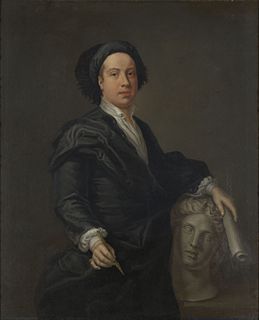
John Nash was one of the foremost British architects of the Regency and Georgian eras, during which he was responsible for the design, in the neoclassical and picturesque styles, of many important areas of London. His designs were financed by the Prince Regent, and by the era's most successful property developer, James Burton, with whose son Decimus Burton he collaborated extensively.

William Kent was an eminent English architect, landscape architect, painter and furniture designer of the early 18th century. He began his career as a painter, and became Principal Painter in Ordinary or court painter, but his real talent was for design in various media.

Euston railway station is a central London railway terminus on Euston Road in the London Borough of Camden, managed by Network Rail. It is the southern terminus of the West Coast Main Line to Liverpool Lime Street, Manchester Piccadilly, Edinburgh Waverley and Glasgow Central. It is also the mainline station for services to and through Birmingham New Street, and to Holyhead for connecting ferries to Dublin. Local suburban services from Euston are run by London Overground via the Watford DC Line which runs parallel to the WCML as far as Watford Junction. There is an escalator link from the concourse down to Euston tube station; Euston Square tube station is nearby. King's Cross and St Pancras railway stations are further down Euston Road.

Sir John Soane was an English architect who specialised in the Neo-Classical style. The son of a bricklayer, he rose to the top of his profession, becoming professor of architecture at the Royal Academy and an official architect to the Office of Works. He received a knighthood in 1831.

Philip Hardwick was an English architect, particularly associated with railway stations and warehouses in London and elsewhere. Hardwick is probably best known for London's demolished Euston Arch and its twin station, the original Birmingham Curzon Street, which stands today as the oldest railway terminus building in the world.

Decimus Burton was one of the foremost English architects and urban designers of the 19th century. He was the foremost Victorian architect in the Roman revival-, Greek revival-, Georgian neoclassical-, and Regency styles. He was accomplished also in the cottage orné-, picturesque-, and neogothic styles. He was a founding Fellow and, later, Vice-President, of the Royal Institute of British Architects, and architect to the Royal Botanic Society from 1840 and an early member of the Athenaeum Club, London, whose club premises he designed and the company of father, James Burton, the pre-eminent property developer of Georgian London, built. Modern architectural historians, such as Guy Williams (1990) and Dana Arnold (2004), contend that Decimus Burton's contribution to architecture has been grossly underestimated by previous architectural historians: as a consequence of the misattribution to Nash of many of his works; of his undeserved vituperation by his neo-gothic nemesis, Augustus W. N. Pugin; and of the consequent retention of his archives by his family.
This is a timeline of architecture, indexing the individual year in architecture pages. Notable events in architecture and related disciplines including structural engineering, landscape architecture, and city planning. One significant architectural achievement is listed for each year.
The year 1914 in architecture involved some significant events.
The year 1819 in architecture involved some significant architectural events and new buildings.
The year 1832 in architecture involved some significant architectural events and new buildings.

George Dancethe younger, RA was an English architect and surveyor as well as a portraitist.

Sir Robert Smirke was an English architect, one of the leaders of Greek Revival architecture, though he also used other architectural styles. As architect to the Board of Works, he designed several major public buildings, including the main block and facade of the British Museum. He was a pioneer of the use of concrete foundations.

Sir John Newenham Summerson was one of the leading British architectural historians of the 20th century.

The Euston Arch, built in 1837, was the original entrance to Euston station, facing onto Drummond Street, London. The Arch was demolished when the station was rebuilt in the 1960s, but much of the original stone was later located—principally used as fill in the Prescott Channel—and proposals have been formulated to reconstruct it as part of the planned redevelopment of the station, including the station's use as the London terminus of the High Speed 2 line.
Philip Charles Hardwick was an English architect.
The year 1824 in architecture involved some significant events.

Harry Bell Measures (1862–1940) was an English architect.
David Mocatta (1806–1882) was a British architect and a member of the Anglo-Jewish Mocatta family.
Thomas Leverton was an English architect.

The statue of John Betjeman at St Pancras railway station, London is a depiction in bronze by the sculptor Martin Jennings. The statue was designed and cast in 2007 and was unveiled on 12 November 2007 by Betjeman's daughter, Candida Lycett Green and the then Poet Laureate Andrew Motion to commemorate Betjeman and mark the opening of St Pancras International as the London terminus of the Eurostar high-speed rail link between the United Kingdom and Continental Europe. The location memorialises the connection between St Pancras station and Betjeman, an early and lifelong advocate of Victorian architecture.












